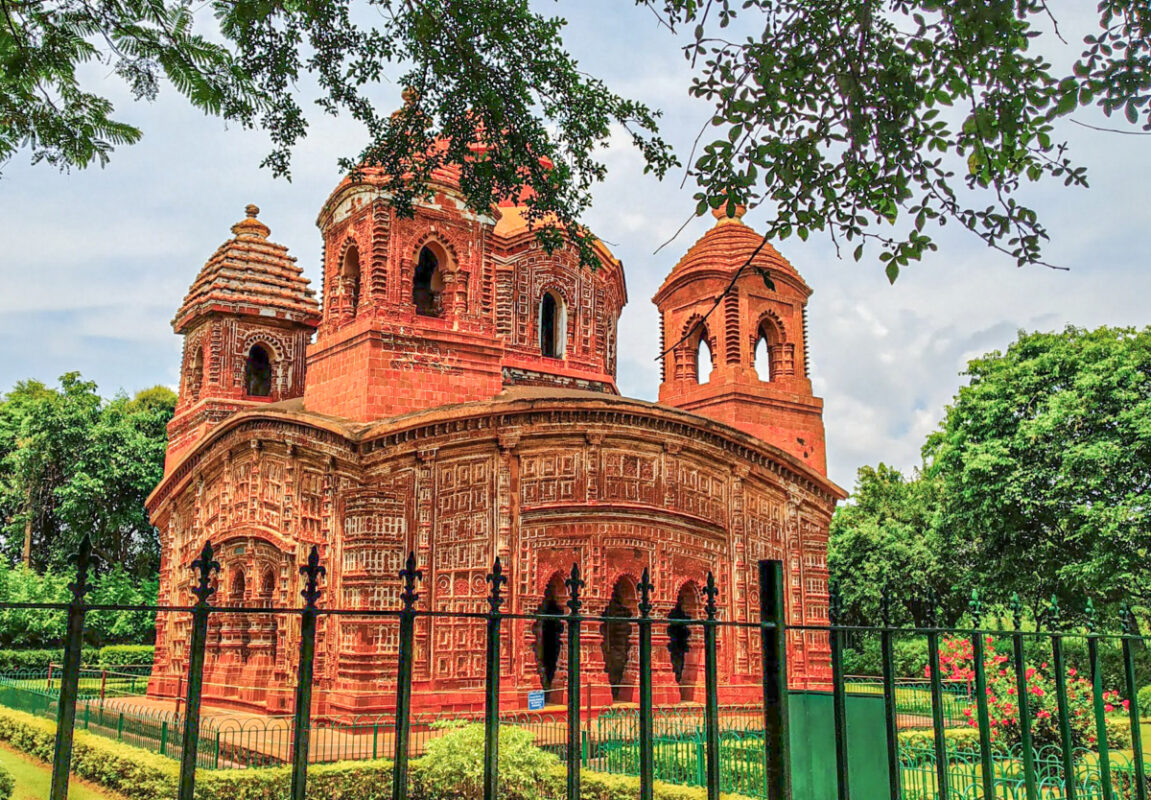West Bengal’s terracotta temples are a testament to the region’s rich cultural heritage, architectural innovation, and artistic excellence. Crafted primarily between the 16th and 18th centuries, these temples showcase the creative brilliance of Bengal’s artisans and their devotion to preserving local traditions. Let’s dive into the details of these architectural heritages of West Bengal.
Historical Context
The terracotta temples of Bengal flourished during the reign of regional rulers like the Malla kings of Bishnupur and influential patrons such as Rani Bhabani. The region lacked abundant stone resources, leading artisans to innovate with terracotta, a material derived from locally available clay. Over centuries, these temples evolved into masterpieces, blending spirituality with artistry.

Architectural Styles and Highlights
Terracotta Panels
The temples are adorned with intricate terracotta panels depicting scenes from Hindu epics like the Ramayana and Mahabharata, as well as everyday life, flora, and fauna. These panels serve as visual narratives of religious devotion and social customs.
Temple Styles
- Ek-Ratna (Single Pinnacle): Seen in temples like Lalji Temple (Bishnupur), characterized by a square base and a single shikhara (spire).
- Pancha-Ratna (Five Pinnacles): Exemplified by Shyamrai Temple, this style features a central spire surrounded by four smaller ones.
- Jor-Bangla (Twin Huts): Unique to Bengal, this style, as seen in Jor-Bangla Temple, mimics the shape of two village huts joined together.
- Chala Style: Inspired by traditional thatched-roof huts, seen in structures like Radha Govinda Temple in Antpur.
Notable Temple Complexes
1. Bishnupur (Bankura District)

- Highlights: Rasmancha, Jor-Bangla Temple, Shyamrai Temple, and Madan Mohan Temple.
- Significance: Bishnupur is often considered the epicenter of terracotta art, with temples showcasing elaborate terracotta reliefs narrating epic tales and daily life.
2. Kalna (Purba Bardhaman District)
- Highlights: The 108 Shiva Temples (circular arrangement), Krishna Chandra Temple, and Lalji Temple.
- Significance: Known for its symmetry and terracotta artistry, Kalna is a spiritual and architectural treasure.
3. Antpur (Hooghly District)
- Highlight: Radha Govinda Temple.
- Significance: Features exquisite terracotta panels that seamlessly blend mythological themes with social narratives.
4. Baranagar (Murshidabad District)
- Highlights: Char Bangla Temple and other 18th-century structures commissioned by Rani Bhabani.
- Significance: This complex stands out for its detailed terracotta carvings and historical importance.
5. Chandrakona (Paschim Medinipur District)
- Highlights: Malleswar Temple and Ramchandra Temple.
- Significance: A smaller but equally artistic hub of terracotta temples, reflecting the legacy of the Malla kings.
Terracotta Art: Beyond Religion
The terracotta temples of Bengal are more than places of worship; they are cultural time capsules. The panels depict not just religious stories but also hunting scenes, music, dance, and even social customs, providing a window into the lives of people from centuries past.
Why Visit West Bengal’s Terracotta Temples?
- Architectural Beauty: Experience the fusion of traditional Bengal hut-style architecture and intricate terracotta reliefs.
- Historical Value: Learn about the socio-political and cultural dynamics of medieval Bengal.
- Spiritual Essence: These temples remain active places of worship, offering a serene and spiritual atmosphere.
Best Time to Visit
The ideal time to explore these temple complexes is during winter (October to February), when the weather is pleasant, and festivals like Ras Mela in Bishnupur provide a vibrant cultural experience.
How to Reach
- By Air: The nearest airport is Kolkata, well-connected to all major Indian cities.
- By Train: Bishnupur, Kalna, and other towns have railway stations with regular connections from Kolkata.
- By Road: These sites are accessible via state highways, with options for private cabs and buses.
West Bengal’s terracotta temples are a must-visit for history buffs, art enthusiasts, and spiritual seekers alike. Each temple tells a story etched in clay, bridging the past with the present. Plan your journey to these ancient marvels and immerse yourself in the timeless beauty of Bengal’s architectural and cultural legacy.
By visiting these treasures, you support the preservation of an invaluable heritage that continues to inspire awe and reverence across generations.

